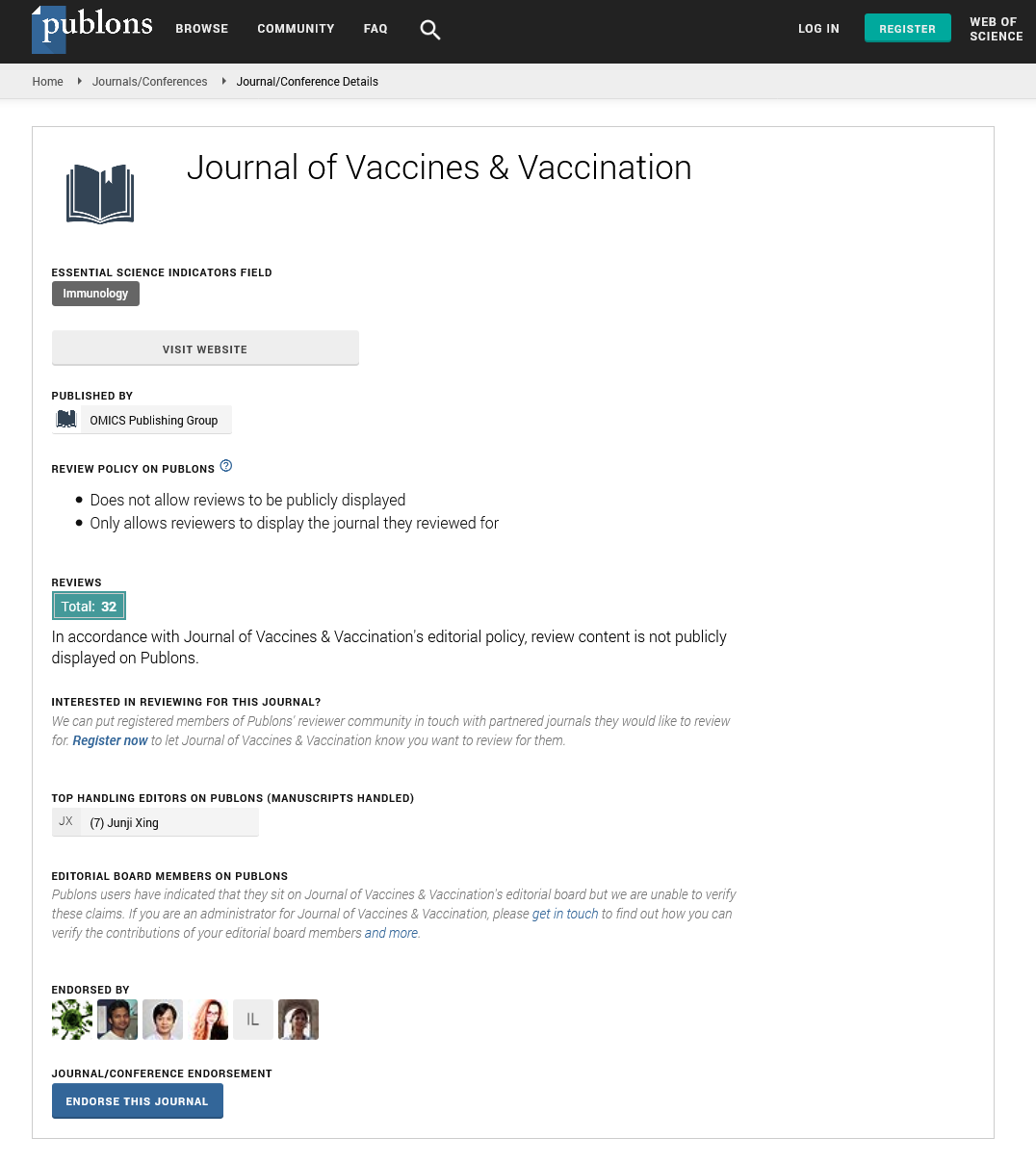PMC/PubMed Indexed Articles
Indexed In
- Academic Journals Database
- Open J Gate
- Genamics JournalSeek
- JournalTOCs
- China National Knowledge Infrastructure (CNKI)
- Scimago
- Ulrich's Periodicals Directory
- RefSeek
- Hamdard University
- EBSCO A-Z
- OCLC- WorldCat
- Publons
- MIAR
- University Grants Commission
- Geneva Foundation for Medical Education and Research
- Euro Pub
- Google Scholar
Useful Links
Share This Page
Open Access Journals
- Agri and Aquaculture
- Biochemistry
- Bioinformatics & Systems Biology
- Business & Management
- Chemistry
- Clinical Sciences
- Engineering
- Food & Nutrition
- General Science
- Genetics & Molecular Biology
- Immunology & Microbiology
- Medical Sciences
- Neuroscience & Psychology
- Nursing & Health Care
- Pharmaceutical Sciences
Perspective Article - (2024) Volume 0, Issue 0
Innovative Vaccine Delivery Methods: Moving Beyond the Needle
Henry Hsu*Received: 29-Jul-2024, Manuscript No. JVV-24-27436; Editor assigned: 31-Jul-2024, Pre QC No. JVV-24-27436 (PQ); Reviewed: 14-Aug-2024, QC No. JVV-24-27436; Revised: 21-Aug-2024, Manuscript No. JVV-24-27436 (R); Published: 28-Aug-2024, DOI: 10.35248/2157-7560.24.S28.003
Description
Novel vaccine delivery systems are fundamentally transforming immunization approaches, offering unprecedented opportunities to improve vaccine effectiveness, acceptance and accessibility worldwide. These innovative delivery methods, including oral, intranasal and transdermal systems, present significant advantages over traditional needle-based administration, potentially revolutionizing global vaccination programs and public health initiatives.
Intranasal delivery systems show particular advantage for respiratory pathogens, potentially providing superior mucosal immunity compared to conventional intramuscular injection routes. Recent advances in formulation technology have significantly improved the stability and immunogenicity of intranasal vaccines. This delivery method reduces natural infection routes for respiratory pathogens, potentially generating more effective and targeted immune responses. Additionally, the non-invasive nature of intranasal delivery may increase vaccine acceptance among needle-phobic individuals and simplify administration procedures in mass vaccination campaigns.
Microneedle patch technology represents another reduces advancement in vaccine delivery. These innovative devices can deliver vaccines painlessly while potentially reducing or eliminating cold chain requirements. The microscopic needles dissolve upon application, delivering precise doses of vaccine antigens directly to immune cells in the skin. This technology offers several advantages: Reduced pain and anxiety, simplified administration requiring minimal training, potential for self-administration and improved vaccine stability at room temperature. Recent clinical trials have demonstrated comparable or superior immune responses compared to traditional injection methods.
Oral vaccine delivery, while challenging due to the harsh gastrointestinal environment, offers significant advantages for mass immunization programs. New encapsulation technologies, engineered probiotics and advanced particle design show promising results in protecting vaccine antigens during oral delivery. These developments could revolutionize vaccination campaigns, particularly in resource-limited settings, by eliminating the need for trained healthcare workers and sterile injection equipment.
The development of combination delivery systems represents an exciting frontier in vaccination technology. These systems might allow co-administration of multiple vaccines or simultaneous delivery of vaccines with immunomodulators, potentially improving vaccination efficiency and reducing the burden on healthcare systems. Advanced formulation strategies, including sophisticated release mechanisms and targeted delivery approaches, enable more precise control over immune response development.
Novel delivery platforms are also addressing critical challenges in vaccine stability and cold chain requirements. Some patch-based and oral delivery systems have demonstrated remarkable stability at room temperature, which could revolutionize vaccine distribution in resource-limited settings. These innovations could significantly reduce vaccine wastage and expand access to remote populations currently underserved due to cold chain limitations.
The integration of smart technology with delivery systems opens new possibilities for vaccination monitoring and compliance tracking. Digital sensors embedded in delivery devices could provide real-time confirmation of vaccine administration and generate valuable data for public health surveillance. These technologies could improve vaccination program efficiency and enable better response to disease outbreaks.
Manufacturing considerations play an important role in the development and implementation of novel delivery systems. Scalable production methods and cost-effective manufacturing processes are essential for widespread adoption. Recent advances in manufacturing technology, including 3D printing and automated assembly systems, are making production of these innovative delivery systems more feasible at scale.
Safety and regulatory considerations require careful attention as these new delivery systems advance toward clinical implementation. Standardized testing protocols and regulatory frameworks must evolve to address the unique characteristics of these novel platforms. International cooperation in establishing guidelines for safety assessment and effectiveness measurement will be important for accelerating development and approval processes.
Looking ahead, the success of novel delivery systems will depend on continued investment in research and development, along with careful attention to cost considerations and manufacturability. These innovations hold tremendous potential for improving global vaccination coverage and responding more effectively to public health emergencies. Continued collaboration between academic institutions, industry partners and regulatory agencies will be essential for realizing the full potential of these transformative technologies.
Citation: Hsu H (2024). Innovative Vaccine Delivery Methods: Moving Beyond the Needle. J Vaccines Vaccin. S28:003.
Copyright: © 2024 Hsu H. This is an open access article distributed under the terms of the Creative Commons Attribution License, which permits unrestricted use, distribution and reproduction in any medium, provided the original author and source are credited.

